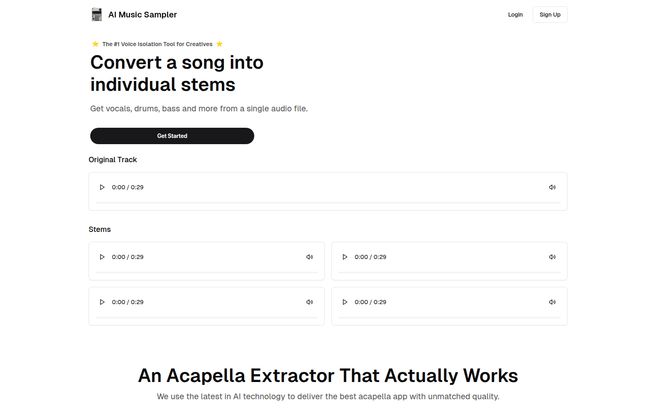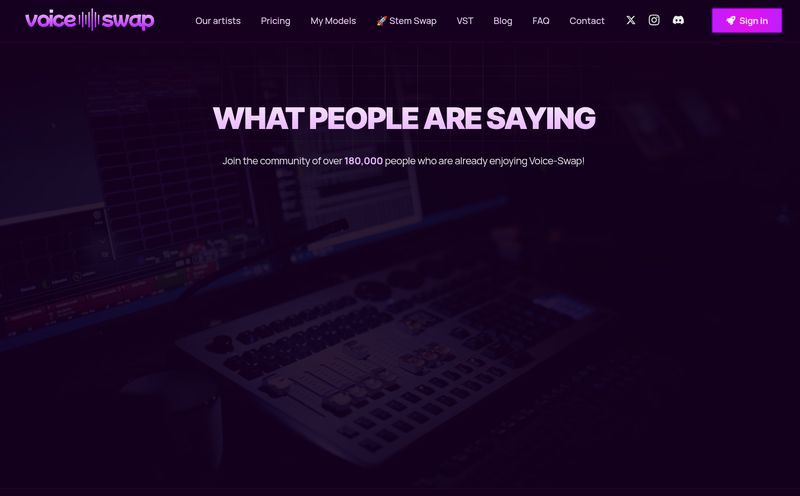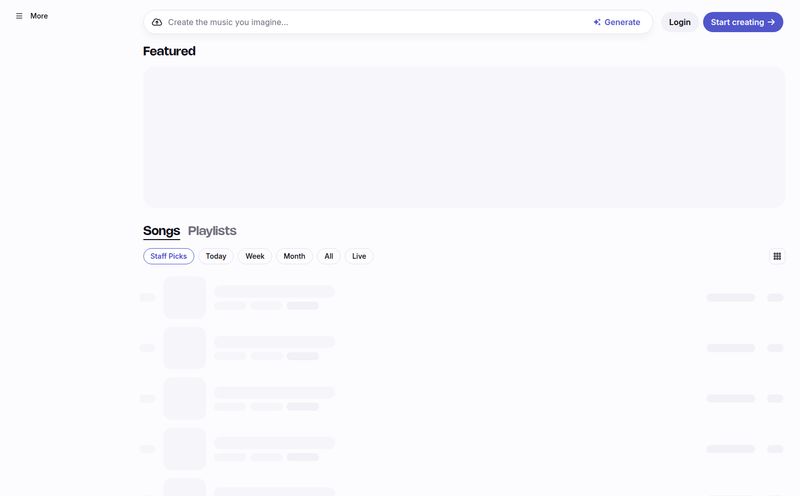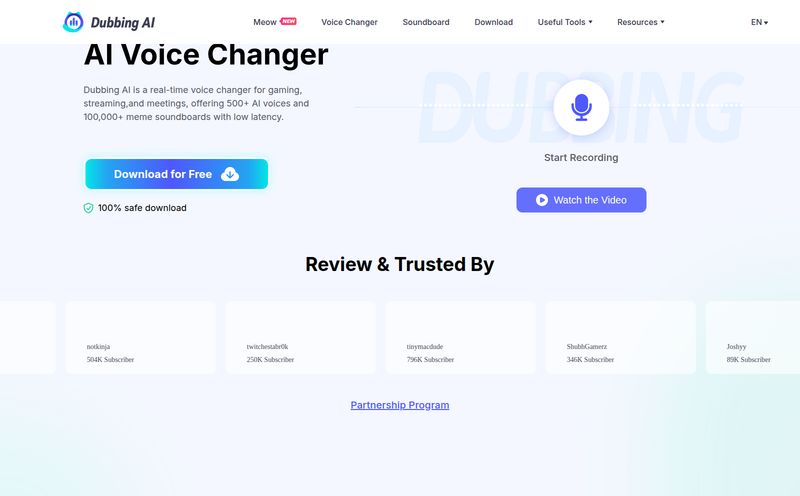How many times have you been deep in a creative project—maybe a remix, a YouTube cover, or even just cleaning up a podcast interview—and hit a brick wall? You need that clean vocal track, that isolated drum beat, but the original multitrack session is long gone. Lost to the digital winds. For years, we’ve relied on clunky software and sketchy online tools that promised the world but delivered a warbly, artifact-filled mess. It was like trying to unscramble an egg, but for audio.
I’ve been in that boat more times than I can count. As someone who lives and breathes SEO and content creation, clean audio is non-negotiable. So when another AI tool promising to solve this age-old problem lands on my desk, I’m usually skeptical. But then I came across AI Music Sampler, and a couple of things immediately caught my eye. No subscription? Lossless quality? Okay, you have my attention.
So, I rolled up my sleeves, grabbed a few tricky audio files, and decided to see if this thing was just another drop in the AI ocean or something genuinely different. Let's get into it.
So, What Exactly is AI Music Sampler?
Before we go further, let's break down what this tool actually is. At its heart, AI Music Sampler is an audio separation tool. You feed it a finished song—a standard MP3, WAV, you name it—and its AI engine acts like a microscopic audio scalpel. It carefully slices the track into its core components, known as “stems.” Think of it as deconstructing a cake back into flour, sugar, and eggs. Suddenly, you have the vocals on one track, the bass on another, drums on a third, and so on.
This isn't just some fancy EQ trick. The platform claims to use advanced neural networks trained on massive audio libraries to identify and reconstruct each part of the sound. This is a far cry from the old-school methods of phase inversion that often left you with hollow, unusable audio. This is digital alchemy, and if it works as advertised, it’s a massive deal for creatives.

Visit AI Music Sampler
My First Impressions: Putting it to the Test
The interface is clean. Almost deceptively simple. There’s no clutter, no confusing menus, just a big friendly button inviting you to upload your track. I appreciate that. We don't need more complicated software in our lives.
For my first test, I chose a dense indie rock track with layered guitars, a driving bassline, and vocals that were slightly buried in the mix. This is usually where other tools fall apart. I uploaded the WAV file and waited. A few moments later, I had a set of individual stems ready to download. The moment of truth.
I clicked play on the isolated vocal track. And... wow. It was clean. Not just 'passable' clean, but genuinely clear. There was a tiny bit of high-hat bleed, which is to be expected, but the core vocal was solid and centered. The bass stem was tight and defined, and the drum track had punch without sounding thin. Color me impressed. It’s not perfect—no AI is—but it’s shockingly close. The claim of being “indistinguishable from magic” on their site felt a little less like marketing fluff and a little more like an honest-to-goodness statement of intent.
The Features That Actually Matter
A tool can have a million features, but only a few usually make a real difference in your workflow. Here's what stood out to me with AI Music Sampler.
That Lossless Audio Quality Promise
This is the big one for any serious audio professional. Many online tools process your audio and then spit out a compressed MP3. You lose data, you lose fidelity, and all that hard work you put into recording goes down the drain. AI Music Sampler works with lossless formats like WAV and AIFF and claims to preserve 100% of the original data. For producers looking for high-quality samples or engineers doing restoration work, this is a non-negotiable feature. You’re getting the actual, uncompromised building blocks of the song to work with.
Vocal Removal vs. Voice Isolation
The site's FAQ makes a subtle distinction here that I found interesting. A 'vocal remover' is what you’d use to create a karaoke or instrumental track—it takes the vocals out. 'Voice isolation,' on the other hand, is about extracting a specific vocal performance, even from a noisy background. This is huge for podcasters, dialogue editors, or anyone who’s ever tried to clean up an interview recorded in a busy cafe. It shows they've thought about different use cases beyond just music production.
Handling the Noise: A Creative’s Best Friend
Let's be real, not every audio source is a pristine studio recording. Sometimes you're sampling from an old vinyl, a noisy live recording, or a video with a ton of background chatter. The ability of AI Music Sampler's AI to distinguish the signal from the noise is probably its most powerful, practical feature. It’s one thing to separate a clean studio track, but it’s another to pull a usable vocal from a file with heavy reverb and competing instruments. From what I saw, it does an admirable job of this, making it a powerful tool for restoration and creative sampling.
The Elephant in the Room: The Pricing Model
Okay, let's talk money. This is where AI Music Sampler really veers off the beaten path. In a world completely saturated with subscriptions—from your music streaming to your project management tools—they’ve gone with a pay-per-usage model. No monthly fees. No yearly commitments. You just pay for what you process.
Honestly, this is a breath of fresh air. I have a dozen subscriptions I barely use, and the 'subscription fatigue' is real. For a freelancer or hobbyist who only needs to separate a handful of tracks a month, this model is fantastic. You use it, you pay for it, and you move on. Simple.
However, there's a flip side. If you're a full-time producer, a DJ constantly making edits, or a studio that needs to process dozens of tracks every single day, the costs could potentially add up. For those power users, a flat-rate subscription from a competitor might be more economical. It’s a classic quality vs. quantity tradeoff, and you have to decide which camp you’re in.
Who Is AI Music Sampler For? (And Who Should Pass?)
So, who should be smashing that 'Get Started' button?
In my opinion, this tool is a perfect fit for DJs and remix artists who need clean acapellas and instrumentals, music producers looking for unique samples to flip, and YouTubers creating cover songs who need high-quality backing tracks. It’s also an incredible asset for podcasters and video editors who need to clean up dialogue and remove background noise. Even karaoke enthusiasts who want a pro-level experience would love this.
Who might want to look elsewhere? As I mentioned, the heavy-duty power user who processes dozens of files daily might find the pay-per-use model less predictable for budgeting. If your workflow is more about sheer volume than pristine quality on every single track, a subscription service might serve you better.
A Quick Summary of My Thoughts
Look, no tool is perfect, and its effectiveness will always hinge on the quality of the audio you feed it. A blurry photo will never become a 4K masterpiece, and the same logic applies here. But AI Music Sampler gets impressively close. The upsides are pretty clear: the audio quality is top-notch, especially with lossless files, and the AI does a fantastic job of handling noise and separating even complex mixes. The user experience is straightforward, and the support for multiple formats is a huge plus. The main consideration is the pay-per-usage pricing—it’s a huge win for occasional users but could be a potential drawback for those with high-volume needs. It's a different approach, and I for one, applaud it.
Frequently Asked Questions (FAQ)
1. Can AI Music Sampler really handle any audio file?
It handles all the major formats you’d expect, including MP3, WAV, AIFF, and FLAC. For the best, lossless results, you’ll want to start with a high-quality file like a WAV or FLAC.
2. How accurate is the vocal separation, really? Is it perfect?
Their site claims up to 99% accuracy, and in my tests, it was very impressive. It’s not always 100% perfect—you might get faint traces of other instruments (what we call 'bleed') depending on the complexity of the original mix. But its results are certainly among the best I’ve heard from an automated tool.
3. Can I use the isolated tracks in my commercial projects?
Yes! Once you've used the acapella extractor to isolate vocals or other stems, you can use them in your projects. However, a crucial reminder: you must ensure you have the necessary legal rights to the original song. AI Music Sampler provides the tool, not the copyright clearance!
4. What makes its AI different from other tools on the market?
According to their site, their technology uses advanced neural networks specifically trained on vast and diverse audio datasets. This allows for more precise identification of vocal frequencies and better separation, preserving the natural quality of the original sound compared to older, more traditional methods.
5. So I really don’t have to sign up for a monthly plan?
Correct. It’s a pay-as-you-go service. You create an account and then pay for the audio you process. This is ideal for anyone who doesn't want to be locked into another monthly subscription.
The Final Verdict
So, is AI Music Sampler a game changer? I'm leaning towards a strong 'yes'. It takes a task that was once incredibly difficult and makes it accessible, fast, and surprisingly high-quality. The decision to ditch the subscription model is a bold move that I think will resonate with a lot of creatives who are tired of being nickel-and-dimed every month.
While it may not be the most cost-effective solution for absolute power users, for the vast majority of musicians, producers, and content creators who prioritize quality and flexibility, AI Music Sampler is a seriously compelling tool. It has definitely earned a spot in my personal digital toolkit.



